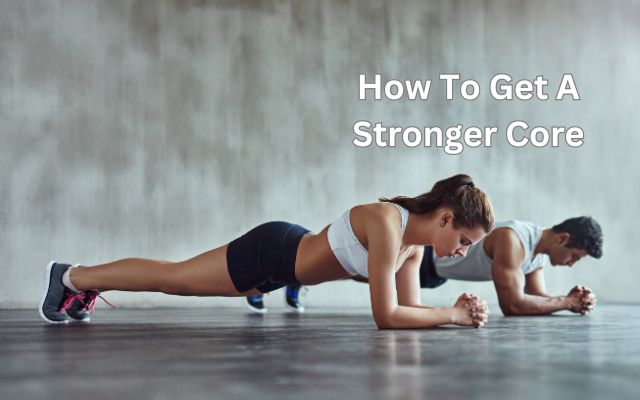How To Get A Stronger Core? 11 Exercises For Stronger Core
Building a Solid Foundation: 11 Core-Strengthening Exercises

How to get a Stronger Core? Core stability provides the foundation for optimal body movement, therefore building a strong core is an important part of training.
As the connector between our lower and upper extremities, our core holds the body together. The core is the driving force and the foundation of support for the entire body, and it generates all motions.
A strong, flexible core will help you avoid injuries, improve sports performance, and correct postural abnormalities, as well as help you pop your abs. Don’t simply think of sit-ups and crunches when it comes to strengthening your core.
Compound movements like squats, deadlifts, shoulder presses, and pull ups are some of the most effective techniques to improve core strength. When done correctly, these
Your core is used in a variety of everyday actions, including pulling a grocery cart and putting on shoes. Your balance, posture, and stability are also affected. Your core, contrary to popular opinion, does not only consist of your abdominal muscles. Muscles in your back and surrounding your pelvis are also included.
How To Get A Stronger Core- Principles Of The Routine
- Perform the exercises in a circuit, pausing for 30 seconds between each one.
- Unless otherwise specified, aim for four to eight repetitions of each exercise or a few seconds in each position.
- If it’s too easy, increase the resistance or abandon the activity.
- When you can’t keep a position or do another rigorous rep or you start to shake, you’ve completed the exercise. To learn the exercises, go through the circuit one time.
- As you develop, two circuits will suffice because the workouts will become more difficult.
- Don’t let bad habits take over.
- Because you’ll substitute for the weaker core muscles by employing the stronger ones, poor form defeats the aim of the workout.
- During the exercises, don’t hold your breath.
- Drop the exercises that become too simple as you build power.
- They will no longer be your limitations, and you will be able to devote more time to the more difficult workouts.
5 Reasons Why You Need To Be Doing Core Exercises
Core Exercises Strengthen Core Muscles
It may seem obvious, but completing core workouts strengthens your core. It’s difficult to build a muscle group without undertaking strengthening workouts!
Improve Posture
What are the benefits of having a strong core? Good posture requires a strong and healthy core. A healthy body, especially a strong back, requires good posture. Slumping in chairs and arching the neck at screens is bad for your posture; a strong core can help you avoid this.
May Improve Running/Training Performance And Balance
Core exercises are beneficial for more than just toning and sculpting six-pack abs. Core workouts can help you improve your overall balance. A sturdy foundation is required for running and training. A solid core aids in the construction and maintenance of that foundation. The core is needed in almost every movement, so strengthening it makes sense!
Core Exercises Help Reduce Injury When Combined With Full-Body Strength Training
A strong core can help you avoid injury as well as improve your running and other activities. Finally, because less time spent injured equals more time and energy for safe training, athletic performance improves. A comprehensive training program that incorporates full-body strength training is an excellent technique to ensure that the body is bulletproof.
Reduce Lower Back Pain And Stiffness
The majority of people have lower back pain and stiffness. Core strengthening can help you feel better. As previously stated, it also reduces the likelihood of re-injury.
Core Or Trunk Includes:
Spinae Erector: The erector spinae is a back muscle that stretches all the way up your trunk. It allows you to straighten up after bending over, bend sideways, and rotate your head.
Abdominal Rectus: When you bend forward, you use the rectus abdominis abdominal muscle. It’s also known as the “six pack” muscle. Obliques. Your internal and external oblique muscles aid in trunk rotation and bending.
Abdominis transverse: The transverse abdominis stabilizes your pelvis by wrapping across the front and side of your trunk. Multifidus. Your spine is supported by the multifidus in your back.
Other Muscles That Make Up Your Core Include
- Pelvic floor
- Diaphragm
- Glutes
- Muscles that attach to the Pelvis (hamstrings, hip flexors, and hip adductors)
Maintaining the strength of these muscles aids in body stabilization, spine support, and general health.
Beginner Moves
Start with any of these introductory moves whether you’re new to fitness or haven’t exercised in a long time. If you have the opportunity, speak with a personal trainer about the appropriate number of reps and sets for your current fitness level and goals.
You’ll see the phrase “tighten your core” throughout these workouts, but how can you know if you’re actually doing it?
Inhale and bring your belly button toward your spine as you do so. For a few seconds, keep your muscles stiff in that position. When you engage — or tighten — your core, it feels like your stomach muscles are supported.
11 Exercises For Stronger Core
Bridge
This position engages your glutes to lift your hips, training your buttocks and thighs while strengthening your core.
- Begin by lying on your back.
- Bend your knees and place your feet at hip width on the floor.
- Put your hands, palms down, at your sides.
- Tighten your glutes and core.
- Raise your hips until your knees and shoulders are in line.
- Hold the position for 10–30 seconds.
- Rep 3–5 times more.
Crunches
Crunches are a well-known core strengthening exercise. Your abdominal muscles are worked when you lift your upper body.
If you experience occasional low back pain, go carefully and start with a few reps when doing crunches.
Before doing this classic crunch, consult a trained trainer or healthcare expert if your low back problem is chronic. It might not be your best option.
- Begin by lying on your back.
- Bend your knees and place your feet at hip width on the floor.
- Your head and spine should be aligned.
- Your arms should be crossed over your chest.
- Relax your neck and shoulders while tightening your core.
- Keep your lower back, pelvis, and feet on the floor by tucking in your chin and lifting your upper back.
- Pause.
- Return to the starting position by slowly lowering your upper back.
- Begin with a single set of 8–12 reps.
Supine Toe Tap
This is a fundamental Pilates move. It works your pelvis, hips, and legs while engaging your core muscles.
Toe taps likewise put less strain on your spine. Toe tapping are a viable substitute to crunches if you already have back problems.
- Begin by lying on your back.
- Elevate your legs to 90 degrees with your bent knees.
- Stick your hand, palms down, at your sides.
- Tighten your abdominal muscles.
- Keep your left leg stationary and your back flat as you drop your right foot and lightly tap the floor.
- Return to starting position by raising your right leg.
- Rep with your other leg.
- Begin with a single set of 8–12 reps.
Bird Dog
The bird dog strengthens both your abdominal and back muscles, making it an excellent core exercise.
It also tests your balance, coordination, and stability.
- Begin on all fours, with your hands beneath your shoulders and your knees beneath your hips.
- Tighten your abdominal muscles.
- Raise your right leg to hip level and straighten it.
- Lift and stretch your left arm to shoulder level, palm down, at the same time.
- Maintain a neutral spine by extending your arm and leg without arching your back.
- Pause.
- Rep using your right arm and left leg.
- Begin with a single set of 8–12 reps.
Bicycle Crunch
This crunching variation targets your obliques, rectus abdominis, and hips.
Begin on the ground with your back against the wall and your left leg bent and drawn towards your chest.
Maintain a small lift off the floor with your right leg. Place your hands beneath your neck or on the lower half of your head, being careful not to tug on your neck.
- Lift your right shoulder off the floor and bring your right elbow toward your left knee with your left knee bent and your right leg straight.
- Extend your left leg while bending and pulling your right knee toward your chest as you return your right shoulder to the floor.
- Lift your left shoulder off the floor and pull your left elbow toward your right knee while your right knee moves in more.
- Begin with three sets of 12 alternating reps.
Intermediate Moves
As you gain strength, progress to these intermediate workouts.
Plank
The plank is a core-targeting full-body workout. Arms, shoulders, back, glutes, and legs are also strengthened.
Keep your legs on the floor and your weight over your hands to make this exercise simpler.
From your legs to your shoulders, maintain a straight line.
- Begin on both hands and knees, with your hands beneath your shoulders and knees below your hips.
- Keep your feet hip-width apart and straighten your legs behind you.
- Tighten your abdominal muscles.
- Hold the position for 10–30 seconds.
- Rep 3–5 times more.
Warrior Crunch
This crunch version engages your core and lower body muscles, such as your thighs, glutes, and quadriceps.
- Stand with your toes turned outward and your feet somewhat wider than shoulder width.
- Close your eyes and open your chest with your hands behind your head.
- Tighten your glutes and core.
- Bring your thighs level to the floor by bending your knees.
- Bend your right elbow toward your right leg as you bend your torso to the side.
- Rep on the other side.
- Begin with a single set of 8–12 reps.
Bird Dog With Elbow To Knee
The smooth movement in this variant on the traditional bird dog engages your abs and back while developing core mobility.
- Begin on all fours, with your hands beneath your shoulders and your knees beneath your hips.
- Tighten your abdominal muscles.
- Raise your right leg to hip level and straighten it.
- Lift and stretch your left arm to shoulder height, palm down, at the same time.
- Raise your right knee and left elbow in close proximity.
- Return to your original starting position.
- Begin with a single set of 8–12 reps.
- Rep on the opposite side.
Advanced Moves
Challenge yourself to an advanced core workout once you’ve mastered intermediate moves. These workouts would improve core strength by challenging your muscles in new ways.
Mountain Climber
This intermediate exercise combines a planks with knee motions, making it a great routine for core strength and balance.
- Begin in a plank position, with your hands beneath your shoulders.
- Tighten your abdominal muscles.
- Keep your back straight and your hips down as you lift your right knee toward your chest.
- Lift your left knee toward your chest as you return your right leg to the beginning position.
- Alternate legs as needed.
- Begin with a single set of 8–12 reps.
Side Plank With Rotation
This is a more difficult variant of the basic plank. Combining a side plank with arm motions improves your arms, shoulders, and obliques.
- Lie on your right side, forearm below shoulder.
- Extend your legs and place your left foot on top of your right.
- Tighten your abdominal muscles.
- To establish a straight line with your body, lift your hips.
- Extend your left arm to shoulder height.
- Bring your left arm beneath your body and rotate your torso towards to the floor.
- Return towards the beginning position by rotating your torso and straightening your left arm.
- Begin with a single set of 8–12 reps.
- Rep on the opposite side.
Read Also: 10 Tips For Exercise In Summer Season
Turkish Get-Up
This full-body action is an excellent technique to improve hip, lumbar, and thoracic spine mobility while also increasing spinal stability. It’s also beneficial for strengthening the ab muscles that surround your spine and your shoulders.
Try this activity without a weight for a few reps, then add a modest weight (like 5 pounds) to see if your shoulders are stable enough to carry weight overhead. As your strength improves, use a heavier weight.
- Lie on your back with your legs straight out and your arms at a 45-degree angle at your sides.
- Bend your right leg and place your right foot a few inches from your buttocks on the floor.
- Make a fist with your right hand and point your knuckles toward the ceiling as you raise your right arm straight up toward the ceiling (this helps with shoulder stabilization).
- Concentrate your attention on your fist; this is where the weight will eventually fall.
- Throughout the entire maneuver, hold your fist precisely above your shoulder.
- Next, push up onto your left elbow with your right heel and left elbow, making sure your chest is pointing out in front of you rather than up.
- Then, with your left hand on the floor, pull your body into a seated position, relying on your abs for the majority of the work.
- Next, slide your left leg underneath you, aligning your left knee and ankle with your left hand.
- Kneel down on the ground with your left knee and right foot, withdrawing your left hand from the floor as you do so.
- Hold your right arm high while pressing your right foot into the ground and bringing your left leg forward, as if lunging.
- You should now be on your feet! Replace your back on the ground and repeat the steps in reverse.
- Begin with 3–5 repetitions.
Wrapping Up
Core-strengthening exercises are a wonderful place to start if you’re wanting to start a regular fitness regimen or add a little extra to an existing one. Before beginning a new fitness routine, consult your healthcare provider. Consult a skilled personal trainer if you have a past or current back problem. They can show you how to tone and exercise your core safely.
Disclaimer
The information on this site is provided solely for educational reasons and is not intended to replace medical treatment provided by a healthcare professional. Because each person’s needs are different, the reader should check with their doctor to see if the material is appropriate for them.
People May Ask
Q- When you don’t have one, how do you strengthen it?
A- Yoga and Pilates are excellent techniques to strengthen your core without overstretching since you can control how much you stretch. Z. Rasmus Sit-ups aren’t necessary to build your abdominals. Tuck your belly in as much as you can while sitting, hold and tighten for a minute, rest, and repeat.
Q- Why do I have a weak core?
A- Surgery, injury, or inactivity can cause muscle weakness or impaired control of certain muscles. Common indicators of core muscle weakness or loss of control can cause movement dysfunction and, as a result, damage your quality of life. Here are some of the most prevalent signs of inadequate core stability.
Q- Is walking good for your core?
A- Yes. Walking is a great kind of exercise because it works both your anaerobic and core muscles.
Q- How long does it take to build core strength?
A- “It can take anywhere from four to eight weeks, depending on what workouts you’re doing and your eating habits,” she says, referring to strengthening and growing ab muscles rather than seeing them.
Q- How do you address basic issues?
A- With core dysfunction-related diseases including chronic lower back pain, breathing exercises have been demonstrated to enhance pain and quality of life. When breathing patterns are rectified, the deep abdominal, pelvic floor, and spinal muscles perform best.



